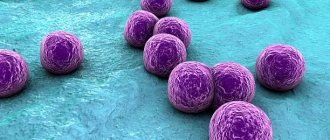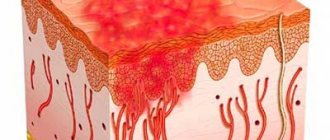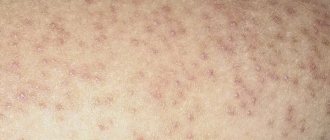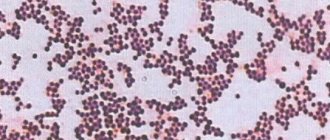This is a special category of bacterial cultures, many species of which are dangerous to human health. Staphylococci are commonly called opportunistic microbes. Living in the body constantly, they are under the control of the immune system. But when the protection is weakened, they can provoke an inflammatory process. Some bacteria are extremely resistant to antimicrobial agents and often cause superinfections.
About the disease
When grown in a petri dish containing blood agar, Staphylococcus aureus colonies have a characteristic golden yellow color, hence the name. This microorganism is extremely common, colonizing about a quarter of the world's population.
It usually spreads in the nasal cavity, groin area, armpits and other parts of the skin, but in most cases it is a normal part of human skin flora and does not cause any problems.
However, as the number of bacteria on the skin increases, they begin to penetrate into the deeper layers of the skin through microcracks and can lead to skin infections and abscesses.
Pathological processes can affect not only various internal organs, such as the liver, kidneys, spleen, brain, but also muscles, bones and joints, which leads to extremely disastrous consequences, therefore, if you suspect an infection, you should immediately consult a doctor.
What is staphylococcus
It is a nonmotile, spherical, Gram-positive microorganism that forms numerous colonies. Staphylococci are anaerobic - they can exist and reproduce without oxygen, in a closed environment. There are more than twenty strains of bacteria. Some of them are quite harmless, while others cause powerful pathological reactions in the human body. Parts of the body and organs most vulnerable to staphylococci:
- leather;
- mucous membranes;
- connective tissue;
- subcutaneous tissue;
- nerve tissue;
- heart muscle.
By infecting them, microbes produce toxic substances and provoke inflammation, which in severe cases leads to sepsis, irreversible changes in structures or permanent dysfunction.
Types of staphylococcal infections
There are several most common types of staphylococci:
● Hemolytic staphylococcus.
Most often, this infection affects the upper respiratory tract, causing purulent sore throat, pharyngitis, tonsillitis, bronchitis and other inflammatory diseases. These bacteria are very resistant and difficult to treat.
● Golden.
This microorganism is extremely resistant to almost all types of penicillin antibiotics, antiseptics, high temperatures, and active direct sunlight. It causes various skin lesions, such as eczema, abscess, boils, lesions of the gastrointestinal tract, upper respiratory tract, mucous membranes, and in the worst case leads to toxic shock.
● Epidermal.
This microorganism lives on the surface of the skin and mucous membranes of any healthy person and does not cause any harm. But, if this bacterium enters the blood of a person with a weakened immune system, which most often occurs during surgical operations, the use of improperly processed instruments, catheters, blood poisoning occurs, which leads to inflammation of the inner lining of the heart.
● Saprophytic.
Despite the fact that this species is the least dangerous, when infected it leads to general intoxication of the body due to the release of dangerous toxins and enzymes during its life processes. These microorganisms often cause inflammation of the urethra and bladder. This is mainly typical for women due to the anatomical features of the structure of their genitourinary system. If left untreated, cystitis leads to kidney inflammation and problems conceiving a child.
Symptoms
Bacterial gastroenteritis is a fairly aggressive disease characterized by acute symptoms. Violations of intestinal functions make themselves felt already on the first day of the development of the disease. The following symptoms may appear:
- Nausea and profuse vomiting.
- Prolonged diarrhea.
- Cramping abdominal pain and abdominal muscle cramps.
- Presence of blood in the stool.
- Fever.
- Dizziness and impaired consciousness.
- Weakness and loss of appetite.
- Headache.
- Reduced blood pressure.
The appearance of fever and abnormal blood pressure may require urgent hospitalization. The most dangerous symptoms of bacterial gastroenteritis are associated with dehydration, which can cause death in the patient. In addition, you should consult a doctor if symptoms do not go away within five days.
Symptoms and forms of staphylococcus in adults and children
The symptoms experienced by the patient vary greatly depending on the method and location of infection and the state of the immune system. But a number of the most characteristic features can be identified:
● elevated temperature;
● suppuration of cuts, swelling, purulent rashes on the skin and mucous membranes, itching and redness of the eyes;
● lack of sense of smell and nasal breathing;
● sore throat, pain when swallowing, dry cough;
● nausea, vomiting, general weakened state;
● severe headaches, epileptic attacks, severe shortness of breath;
● painful sensations in the joints.
One of the most common forms of staphylococcus in adults is its asymptomatic carriage. A healthy person does not feel any signs of the disease until a provoking factor appears that gives impetus to the development of the disease.
For women, the most dangerous form is the saprophytic form, which can lead to cystitis. This is due to the fact that the women’s urethra is located very close to the vagina, which is why there is a high probability of pathogenic microflora, including staphylococcus bacilli, entering the urethral canal, and then into the bladder, causing its inflammation.
Since young children do not have a strong immune system, the risk of developing an infection in a child is quite high. Moreover, even those types of staphylococcus that cause practically no problems in adults can lead to serious complications in children. Staphylococcus is especially dangerous in children under one year of age, as it can easily spread throughout the body in the shortest possible time and lead to serious consequences, including death.
Secret weapon
The product of the lug operon isolated by Zipperer turned out to be a non-ribosomal cyclic peptide consisting of five amino acids (two D-valines, L-valine, D-leucine and L-tryptophan) and a thiazolidine heterocycle (Fig. 4). The antibiotic was named lugdunin.
Figure 4. Gene cluster, biosynthetic pathway, and chemical structure of lugdunin. a — Genes of “subunits” (not modules!) of non-ribosomal peptide synthetase of S. lugdunensis: lugA, B, C and D. b — Functional domains of operon products: A - adenylating, P - peptidyl, C - condensing, E - epimerizing, R - reductase. Their specific combinations make up modules—the individual catalytic units of an enzyme. The biosynthesis of lugdunin apparently begins in the initiator module LugD and continues sequentially with the help of LugA-C. c — Structural formula of lugdunin.
[1]
By chemical synthesis, it was possible to obtain a product with chemical properties and antibacterial effect identical to natural lugdunin. Scientists have suggested that this antibiotic inhibits the synthesis of bacterial biopolymers - proteins, DNA and peptidoglycans [5].
Non-ribosomal peptides
This class of peptides is synthesized in the cells of lower fungi and bacteria without the participation of ribosomes. Non-ribosomal peptides (NRPs) are also found in higher organisms that have commensal bacteria [12].
NRPs are divided into several functional groups [13]:
- antibiotics (vancomycin);
- antibiotic precursors (ACV tripeptide - a precursor to penicillin and cephalosporin);
- immunosuppressants (cyclosporine);
- antitumor peptides (bleomycin);
- siderophores (pyoverdine);
- toxins (HC-toxin);
- surfactants (surfactin).
Structure
Nonribosomal peptides range from 2 to 50 amino acids in length and often have a cyclic or branched structure. They contain both “regular” proteinogenic and non-proteinogenic amino acids - D-forms or residues modified by the addition of N-methyl and N-formyl groups, glycosylation, hydroxylation, acylation or halogenation. Cyclization occurs through the formation of oxazolines and thiazolines in the peptide backbone [12].
Synthesis
NRPs are synthesized by non-ribosomal peptide synthetases (NRPS), which do not follow “foreign” instructions in their work, that is, they do without mRNA. NRPS are giant multimodular enzymes, each of which can synthesize only one type of peptide. A separate enzyme module is responsible for the inclusion of one amino acid in the peptide chain; therefore, the number of modules corresponds to the length of the peptide [14].
Each module consists of at least three domains:
- condensing (accepting the peptide chain from the previous module);
- adenylating (selecting the desired amino acid);
- peptidyl (forming a peptide bond).
Modules often include other domains, including the epimerizing domain, which converts L-amino acids into D-forms [14].
By analogy with the triplet ribosomal code for protein synthesis, there is also a non-ribosomal NRPS code, determined by 10 amino acid residues in the substrate-binding pocket of the adenylation domain. The combination of these residues determines which amino acid will be integrated into the peptide by a specific NRPS module. Knowing this code, it is possible to predict the substrate specificity of adenylation domains and even arbitrarily change it by replacing amino acids in the domain [14].
In experiments by German scientists, lugdunin acted not only on methicillin-resistant staphylococci, but also on glycoprotein-resistant, and even on other gram-positive bacteria such as listeria and vancomycin-resistant enterococcus (Table 1).
The minimum inhibitory concentration (MIC) of the new bacteriocin is 1.5–12 μg × ml−1, which indicates the high activity of the substance. However, such concentrations had no effect on human serum, did not cause lysis of neutrophils or red blood cells, and did not inhibit the metabolic activity of monocytes. Bacterial cells exposed to lugdunin at concentrations even below the MIC stopped synthesizing DNA, RNA, proteins and cell wall components. In this respect, lugdunin is similar to daptomycin, which has the same effect, but whose mode of action has not yet been studied. No resistance of S. aureus cells to lugdunin was observed even after they had been grown for a month at low concentrations. Table 1. Spectrum of activity of lugdunin
| Types and strains | Resistance | MIC of lugdunin (μg × ml−1) |
| Staphylococcus aureus USA300 (LAC) | MRSA | 1,5 |
| + 50% human serum | 1,5 | |
| Staphylococcus aureus USA300 (NRS384) | MRSA | 1,5 |
| Staphylococcus aureus Mu50 | GISA | 3 |
| Staphylococcus aureus SA113 | 3 | |
| Staphylococcus aureus RN4220 | 3 | |
| Enterococcus faecium BK463 | VRE | 3 |
| Enterococcus faecalis VRE366 | VRE | 12 |
| Listeria monocytogenes ATCC19118 | 6 | |
| Streptococcus pneumoniae ATCC49619 | 1,5 | |
| Bacillus subtilis 168 (trpC2) | 4 | |
| Pseudomonas aeruginosa PAO1 | >50 | |
| Escherichia coli DH5α | >50 | |
| Legend: MRSA - methicillin-resistant S. aureus; GISA—glycoprotein-resistant S. aureus; VRE—vancomycin-resistant Enterococcus. Table from [1]. | ||
Causes
Most often, the bacterium enters the human body through wounds and microcracks in the skin. The infection, having penetrated through the wound, begins to multiply in the blood, spreading throughout the body and affecting the lungs, heart, brain, liver, kidneys, and joints.
With staphylococcus, diseases can be very different, such as pneumonia, meningitis, osteomyelitis, endocarditis, sepsis and many others.
Staphylococcus infection can occur in the following ways:
● Through contact and household use when using the patient’s personal items;
● Airborne droplets during close contact with an infected person;
● Fecal-oral on dirty fruits, vegetables and other food products, dirty dishes and hands;
● Vertical when a child passes through the birth canal of an infected mother during childbirth.
● Infection often occurs during surgery through medical instruments and during various manipulations.
Bacterial infection of the deep layer of skin
Occurs when microbes enter deep into the dermis.
Furuncle
First, a painful node appears, then an abscess matures in its center. After 5–7 days it opens, a purulent-necrotic core is released, and the wound is scarred. When there is more than one lesion, they speak of furunculosis.
Carbuncle
These are several boils united into a common infiltrate. The place looks like a purple-bluish tumor. Pain increases, well-being suffers, body temperature rises. After opening the formation, a deep ulcer remains, healing with a scar.
Acne (blackheads)
- inflammation of the sebaceous gland ducts due to blockage. Pustules form on the face, chest, and shoulders. Their contents dry out to crusts, after which, when rejected, scars or bluish spots remain.
Hidradenitis
Purulent inflammation of the sweat glands. The process often recurs. Favorite localizations are armpits, inguinal folds, under the mammary glands. Deep painful nodes appear, bluish-red on the outside. They are opened with the separation of liquid pus.
Erysipelas
Occurs in people who are individually predisposed. Foci of inflammation are clearly limited. The affected area is swollen, hot, bright red, with bursting blisters. The disease is accompanied by fever, intoxication, and severe pain.
Deep pyoderma can be complicated by inflammation of the lymphatic vessels and nodes, abscess, and sepsis.
Diagnostics
Only a doctor can diagnose the presence of infection based on the results of a staphylococcus test.
It is worth remembering that testing is recommended only if symptoms of the disease are present. The presence of bacteria in biological material may mean that a person is its carrier, which in itself is the norm.
For analysis, material is taken from the area where the infection is believed to be developing. To detect a pathological process, several tests are carried out to track the dynamics of bacterial growth. If their number increases rapidly, the presence of a staphylococcal infection can be diagnosed. Also, additional analysis will determine the specific type of infection so that the doctor can choose a personal treatment regimen.
Literature
- Zipperer A., Konnerth MC, Laux C., Berscheid A., Janek D., Weidenmaier C. et al. (2016). Human commensals producing a novel antibiotic impair pathogen colonization. Nature. 535, 511–516;
- Dobson A., Cotter P. D., Ross R. P., Hill C. (2012). Bacteriocin production: a probiotic trait? Appl. Environ. Microbiol. 78, 1–6;
- Donia MS, Cimermancic P, Schulze CJ, Wieland Brown LC, Martin J, Mitreva M et al. (2014). A systematic analysis of biosynthetic gene clusters in the human microbiome reveals a common family of antibiotics. Cell. 158, 1402–1414;
- Antimicrobial peptides are a possible alternative to traditional antibiotics;
- Lewis K. and Strandwitz P. (2016). Antibiotics right under our nose. Nature. 535, 501–502;
- Wikipedia: “Staphylococcus aureus”;
- Karpov I.A. and Kachanko E.F. (2005). Staphylococcal infection: clinical aspects and prospects for therapy. Medical news. 9, 53–56;
- Mandal A. (2012). What is Staphylococcus aureus? News-Medical.net;
- Naber C. K. (2009). Staphylococcus aureus bacteremia: epidemiology, pathophysiology, and management strategies. Clin. Infect. Dis. 48 , S231–S237;
- Staphylococcus aureus (Staphylococcus aureus). GastroScan;
- Mobile genetic elements of prokaryotes: stratification of the “society” of vagabonds and homebodies;
- Wikipedia: “Non-ribosomal peptides”;
- Caboche S., Pupin M., Leclère V., Fontaine A., Jacques P., Kucherov G. (2008). NORINE: a database of nonribosomal peptides. Nucleic Acids Res. 36 , D326–D331;
- Mironovskiĭ ML, Ostash BE, Fedorenko VA (2010). Diversity of genes encoding nonribosomal peptide synthetases in the Streptomyces sioyaensis genome. Genetika. 46, 896–903.
Treatment
Staphylococcus can be treated surgically if there is a purulent lesion in the area of infection. It may also be necessary to remove an infected implant, catheter, etc.
As a conservative treatment for staphylococcus, antibiotics and antibacterial agents are used in combination with immunomodulatory therapy. The drugs are selected taking into account the resistance of staphylococcus to a wide range of medications. The use of brilliant green solution for treating infected wounds has shown greater effectiveness.
What tests need to be taken
First of all, to determine the presence of infection, a staphylococcus test is taken.
For diseases of the respiratory tract, a swab is taken from the nasopharynx and oropharynx, for cystitis - urine, for gastrointestinal disorders - feces, for skin lesions - a scraping from the skin, and if there is a suspicion of extensive infection, they donate blood.
Also, before starting treatment with antibiotics, it is required to be tested for resistance to these medications.
Which doctor should I contact?
Advanced cases of the disease are dealt with by an infectious disease specialist.
But if you just have suspicions and want to get an accurate diagnosis, first you should consult a therapist, or with children, a pediatrician. The doctor will conduct a diagnosis and, based on the results obtained, will write you a referral to the necessary doctor.
Antibiotic resistance of staphylococci
The more we attack, for example, pathogens of purulent-septic infections with antibiotics, the more often antibiotic-resistant microorganisms appear.
Under the influence of antibiotics, the inhibitory effect on staphylococci of other microbes - common inhabitants of our body - is disrupted. Moreover, sometimes antibiotics simply stimulate the development of staphylococci and streptococci. Therefore, without medical prescription, the independent use of antibiotics (and other antibacterial agents) in the event of purulent skin lesions should be excluded.
Any treatment for staphylococcal skin pathologies should be prescribed by a dermatologist! Diseases of other organs are treated by appropriate specialists - gynecologists, urologists, therapists.
General information
Staphylococcus aureus
Staphylococcus aureus belongs to a type of spherical bacteria of the genus Staphylococcus. Microorganisms are gram-positive - they retain pigmentation when washed using the Gram method.
The bacterium has the ability to survive on mucous membranes and outer skin. It doesn't always cause illness. A person may simply be a carrier. There are up to 40% of such people around the globe.
Carriage can be of a different nature - permanent or transient. This circumstance is influenced by the state of the competing microflora, the type of strain and the health of the carrier. The existence of Staphylococcus aureus was discovered by Scottish surgeon Alexander Ogston in 1880.
In 1884, the bacterium was described. The research was conducted by the German physician Ottomar Rosenbach, professor of therapy and pathology. The species is named because of its appearance under a microscope. Most bacteria are colorless when viewed closely, but these microorganisms have a golden hue.
Their color is ensured by the presence of a coloring pigment from the group of carotenoids found in the tissues of organisms. The length of the staphylococcus chromosome is up to 1 micron, and it contains a huge number of genes - more than 2.5 thousand.
Cocci are immobile during their life cycle and attach to the epithelium in pairs or singly. In appearance, their colonies resemble bunches of grapes, which is also reflected in the name of the genus (“staphula” translated from Greek means “bunch of grapes”).










